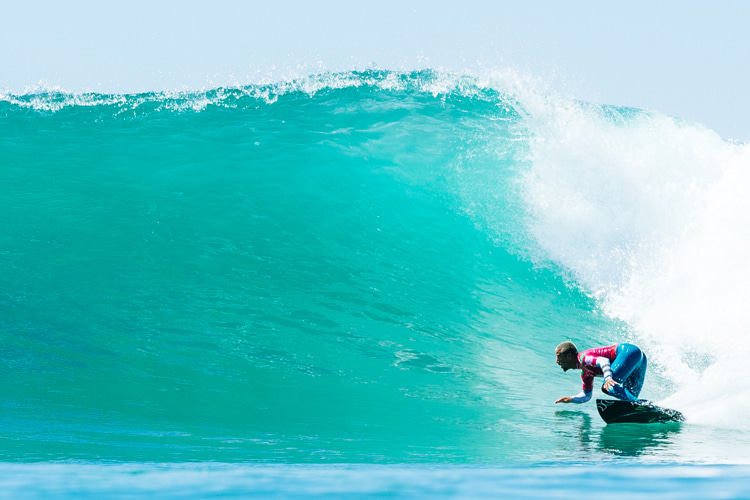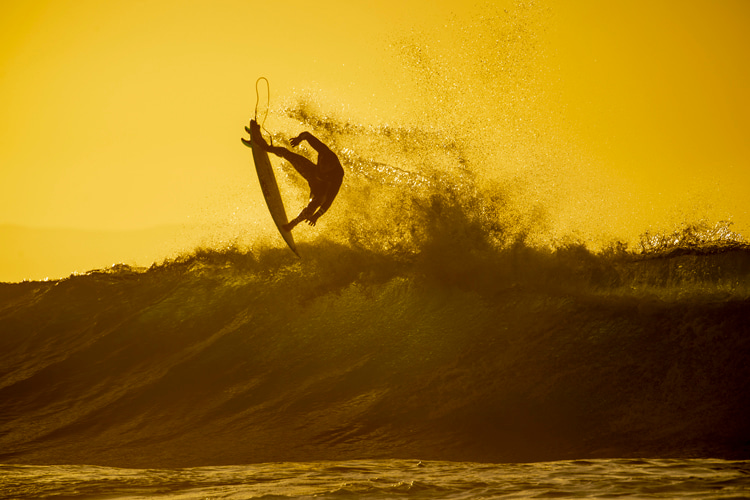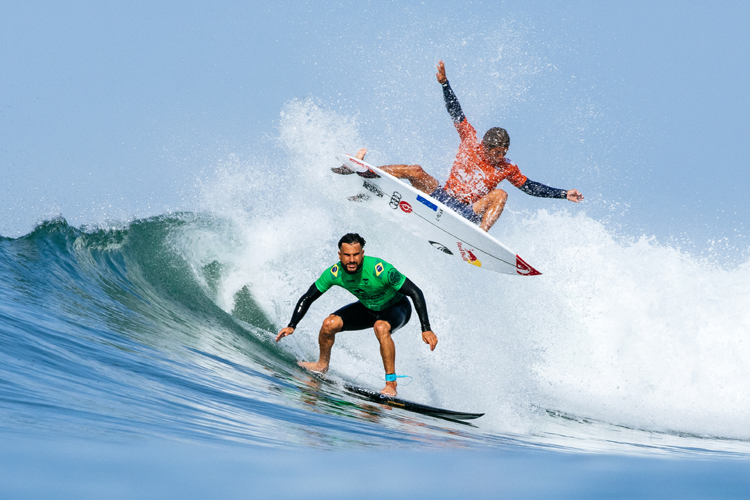There are only a few waves on the planet that can fully put a surfer to the test. Here's everything you need to know about high-performance waves.
People who have never ridden a wave often make several common misjudgments about surfing and what it takes to get to walk on water.
"When the waves are small, they're all out there. Now that it's pumping real big waves, I don't see anyone in the water!"
You might have heard this ignorant comment at least once in your surfing life.
It's one of the most common observations non-surfers make when assessing ocean conditions.
The truth is that the quality of the surf and surfers is not based and does not rely on the size of a moving wall of saltwater.
The biggest wave is not necessarily the best wave for surfing. Actually, it rarely is.
And even if it's big, glassy, and perfectly peeling from one side to the other, it's not the type of wave where you'll assess a surfer's full range of skills.
In most big-wave arenas, the athlete's only goal is to successfully paddle or get towed into it, pop up, and draw a survival line toward its shoulder.
In most rides, surfers skip the bottom turn because there's simply no time for fancy adventures in the giant's trough.
Are you planning to perform a roundhouse cutback on a 90-foot Nazaré wave? There's a multi-ton crest about to fall on your head, dear reader.
So, unless you're Kai Lenny, an advanced surfing maneuver in the so-called wave of consequence might not be the brightest idea.

Wave of Consequence vs. High-Performance Wave
This brings us to the main subject of the discussion. So, what exactly is a high-performance wave?
A high-performance wave is the opposite of what a wave of consequence is.
In a wave of consequence, the surfer rides to "survive."
Their goal is to take a risk and manage it according to their confidence, skills, and knowledge of the spot.
For instance, Teahupoo and Pipeline are two waves of consequence.
Surfers are fully aware that there's a chance of losing their lives trying to tame these natural wonders.
They are surfing in shallow waters. They are taking off slightly above coral reefs. They are getting covered by heavy curtains of water.
People have died surfing Teahupoo, Pipeline, Mavericks, Nazaré, Waimea Bay, and similar waves.
So, how do high-performance waves compare to waves of consequence?
A high-performance wave is a surfing arena where athletes can display the broadest range of maneuvers, tricks, techniques, and skills.
It's the wave that, because of its characteristics, allows surfers to unleash and display their wave-reading competence and physical prowess on a shortboard.
Why are these waves special and unique? Mainly because they're rare and not widely available.

Unique Characteristics
A high-performance wave features the following attributes and elements:
- A-Frame: It's a wave that occasionally breaks simultaneously to the left and to the right. As a result, it could transform into a split peak and allow two surfers to ride each way or even create a backdoor barrel;
- Oblique Wave Face: It's a wave that is not too steep and not too mushy. Consequently, it invites surfers to unload all their technical knowledge and expertise to meet the sport's competitive goal - speed, power, and flow;
- Tube: It's a wave that now and then provides a barreling section that separates the intermediate from the advanced and professional riders.
- Air Section: It's also a wave with plenty of ramps straight out of the tubes or in the closeout section, allowing surfers to showcase their aerial creativity and genius.
- Overhead to Double Overhead: It's a wave with size but not too much. The goal is to provide a clean, fast, playful, open face where the performers can draw their best vertical, top-to-bottom, rail-to-rail surfing.
The high-performance wave is the all-around surfer's ultimate arena.
It's the place for proving that you can tick the boxes of power surfing, tube riding, and aerial excellence.
It's a 360-degree test of your versatility as a modern surfer.
All-Around Surf Spots Across the World
Where can you find these gems? Sadly, there are not many. But you can at least find a few on each continent:
Here are some of the best examples of high-performance waves:
- Lower Trestles (San Clemente, Southern California);
- Ribeira d'Ilhas (Portugal);
- Mundaka (Spain);
- Hossegor (France);
- Snapper Rocks (Gold Coast);
- Punta Roca (El Salvador);
- Jeffreys Bay (South Africa);
- Nias (Indonesia);
- Sunset Beach (Hawaii);
With the average-to-perfect swell and wind conditions, they transform into magical natural amphitheaters to surf - and watch surfing - at the finest level.
These outstanding waves are also the best training grounds, as they will push any surfer toward progression faster than any other surf break.
They are constantly forcing surfers to adapt and get the most out of every inch of the wave, whether by applying foot power over the tail of the surfboard on a critical section, stalling for a quick cover-up, or launching into the air via a pinching crest.
If you've never ridden a wave like this, give it a go at least once in a lifetime. It's undoubtedly worth it.
Words by Luís MP | Founder of SurferToday.com
